Finance: Budgeting, Assets, Liabilities, and Purchasing
VerifiedAdded on 2022/12/30
|10
|2163
|37
AI Summary
This document provides information on various topics related to finance, including budgeting, assets, liabilities, and purchasing. It explains the concept of budgeting and its importance in achieving future goals. It also discusses different types of budgets, such as static and rolling budgets. The document further covers the definition and significance of assets, liabilities, and capital in finance. Additionally, it explores the purchasing process, including the role of purchase orders and invoices.
Contribute Materials
Your contribution can guide someone’s learning journey. Share your
documents today.
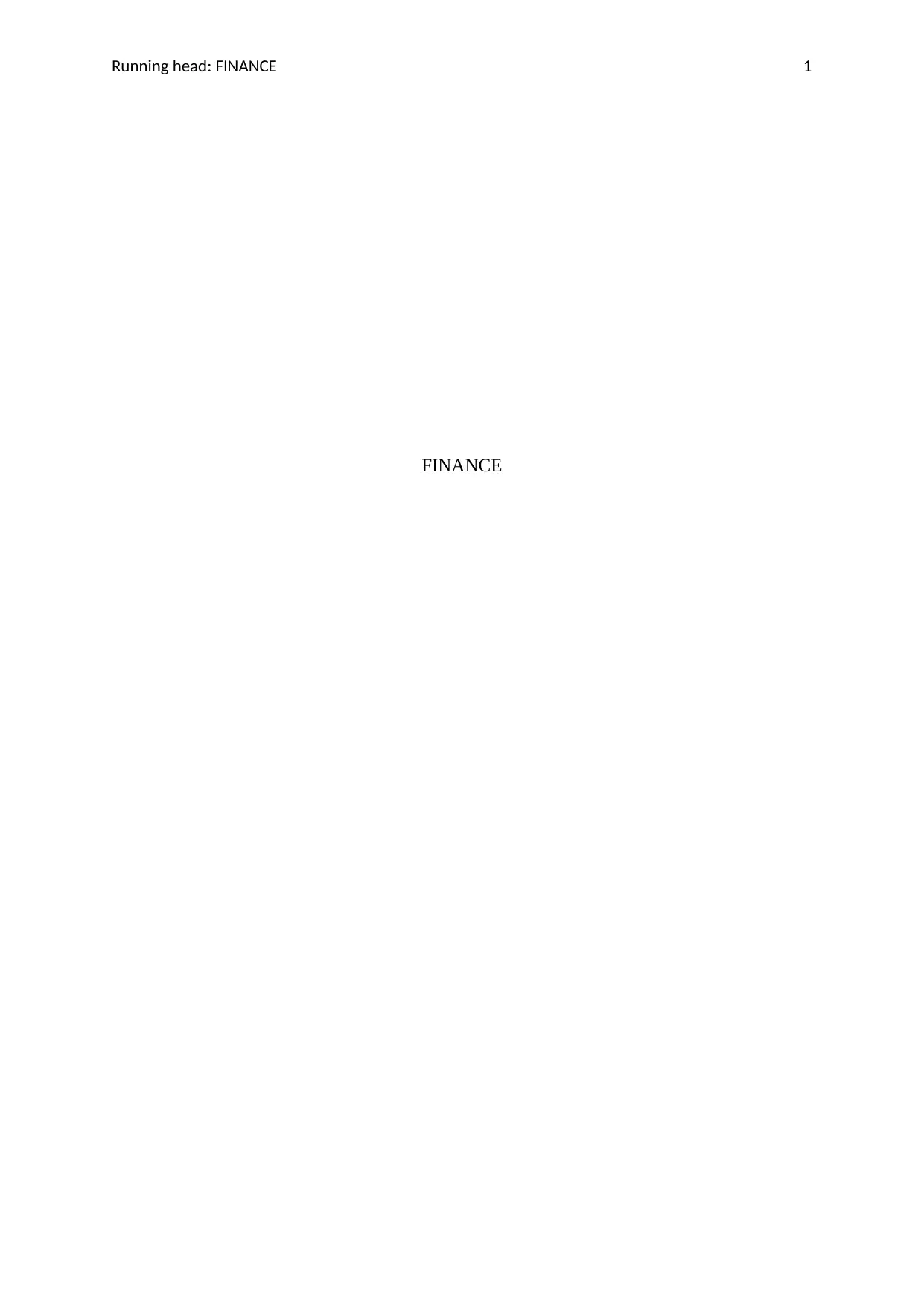
Running head: FINANCE 1
FINANCE
FINANCE
Secure Best Marks with AI Grader
Need help grading? Try our AI Grader for instant feedback on your assignments.
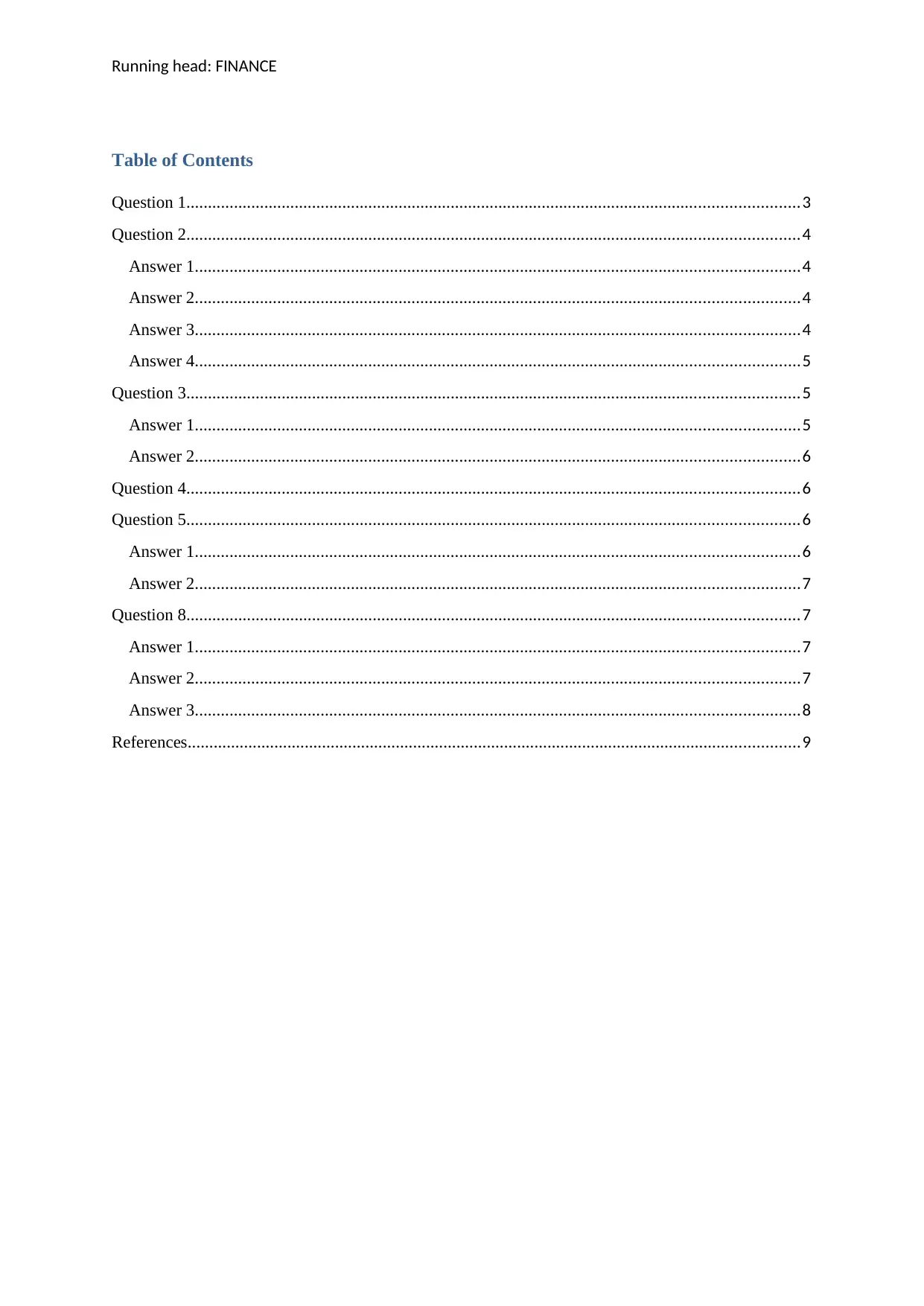
Running head: FINANCE
Table of Contents
Question 1.............................................................................................................................................3
Question 2.............................................................................................................................................4
Answer 1...........................................................................................................................................4
Answer 2...........................................................................................................................................4
Answer 3...........................................................................................................................................4
Answer 4...........................................................................................................................................5
Question 3.............................................................................................................................................5
Answer 1...........................................................................................................................................5
Answer 2...........................................................................................................................................6
Question 4.............................................................................................................................................6
Question 5.............................................................................................................................................6
Answer 1...........................................................................................................................................6
Answer 2...........................................................................................................................................7
Question 8.............................................................................................................................................7
Answer 1...........................................................................................................................................7
Answer 2...........................................................................................................................................7
Answer 3...........................................................................................................................................8
References.............................................................................................................................................9
Table of Contents
Question 1.............................................................................................................................................3
Question 2.............................................................................................................................................4
Answer 1...........................................................................................................................................4
Answer 2...........................................................................................................................................4
Answer 3...........................................................................................................................................4
Answer 4...........................................................................................................................................5
Question 3.............................................................................................................................................5
Answer 1...........................................................................................................................................5
Answer 2...........................................................................................................................................6
Question 4.............................................................................................................................................6
Question 5.............................................................................................................................................6
Answer 1...........................................................................................................................................6
Answer 2...........................................................................................................................................7
Question 8.............................................................................................................................................7
Answer 1...........................................................................................................................................7
Answer 2...........................................................................................................................................7
Answer 3...........................................................................................................................................8
References.............................................................................................................................................9
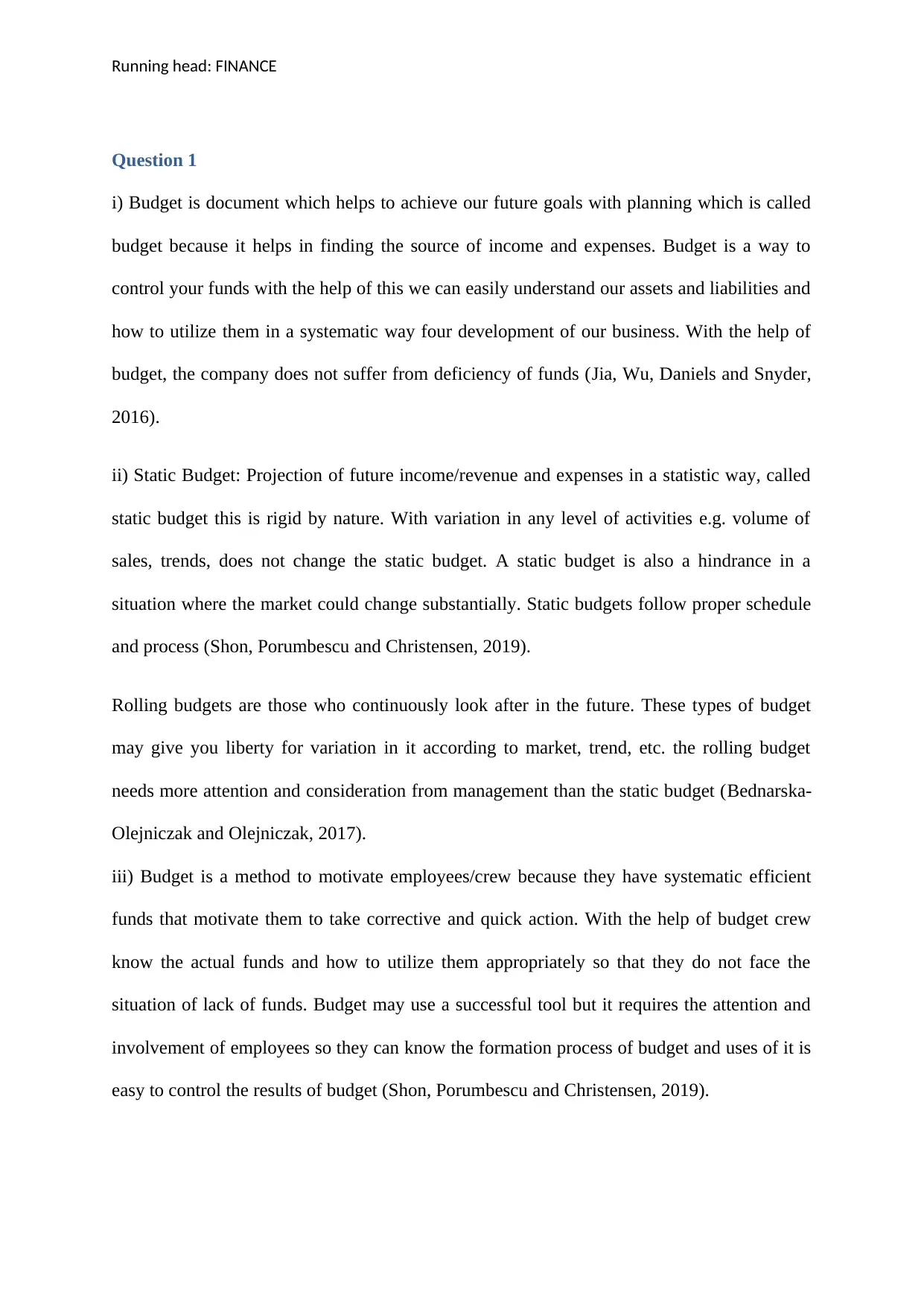
Running head: FINANCE
Question 1
i) Budget is document which helps to achieve our future goals with planning which is called
budget because it helps in finding the source of income and expenses. Budget is a way to
control your funds with the help of this we can easily understand our assets and liabilities and
how to utilize them in a systematic way four development of our business. With the help of
budget, the company does not suffer from deficiency of funds (Jia, Wu, Daniels and Snyder,
2016).
ii) Static Budget: Projection of future income/revenue and expenses in a statistic way, called
static budget this is rigid by nature. With variation in any level of activities e.g. volume of
sales, trends, does not change the static budget. A static budget is also a hindrance in a
situation where the market could change substantially. Static budgets follow proper schedule
and process (Shon, Porumbescu and Christensen, 2019).
Rolling budgets are those who continuously look after in the future. These types of budget
may give you liberty for variation in it according to market, trend, etc. the rolling budget
needs more attention and consideration from management than the static budget (Bednarska-
Olejniczak and Olejniczak, 2017).
iii) Budget is a method to motivate employees/crew because they have systematic efficient
funds that motivate them to take corrective and quick action. With the help of budget crew
know the actual funds and how to utilize them appropriately so that they do not face the
situation of lack of funds. Budget may use a successful tool but it requires the attention and
involvement of employees so they can know the formation process of budget and uses of it is
easy to control the results of budget (Shon, Porumbescu and Christensen, 2019).
Question 1
i) Budget is document which helps to achieve our future goals with planning which is called
budget because it helps in finding the source of income and expenses. Budget is a way to
control your funds with the help of this we can easily understand our assets and liabilities and
how to utilize them in a systematic way four development of our business. With the help of
budget, the company does not suffer from deficiency of funds (Jia, Wu, Daniels and Snyder,
2016).
ii) Static Budget: Projection of future income/revenue and expenses in a statistic way, called
static budget this is rigid by nature. With variation in any level of activities e.g. volume of
sales, trends, does not change the static budget. A static budget is also a hindrance in a
situation where the market could change substantially. Static budgets follow proper schedule
and process (Shon, Porumbescu and Christensen, 2019).
Rolling budgets are those who continuously look after in the future. These types of budget
may give you liberty for variation in it according to market, trend, etc. the rolling budget
needs more attention and consideration from management than the static budget (Bednarska-
Olejniczak and Olejniczak, 2017).
iii) Budget is a method to motivate employees/crew because they have systematic efficient
funds that motivate them to take corrective and quick action. With the help of budget crew
know the actual funds and how to utilize them appropriately so that they do not face the
situation of lack of funds. Budget may use a successful tool but it requires the attention and
involvement of employees so they can know the formation process of budget and uses of it is
easy to control the results of budget (Shon, Porumbescu and Christensen, 2019).
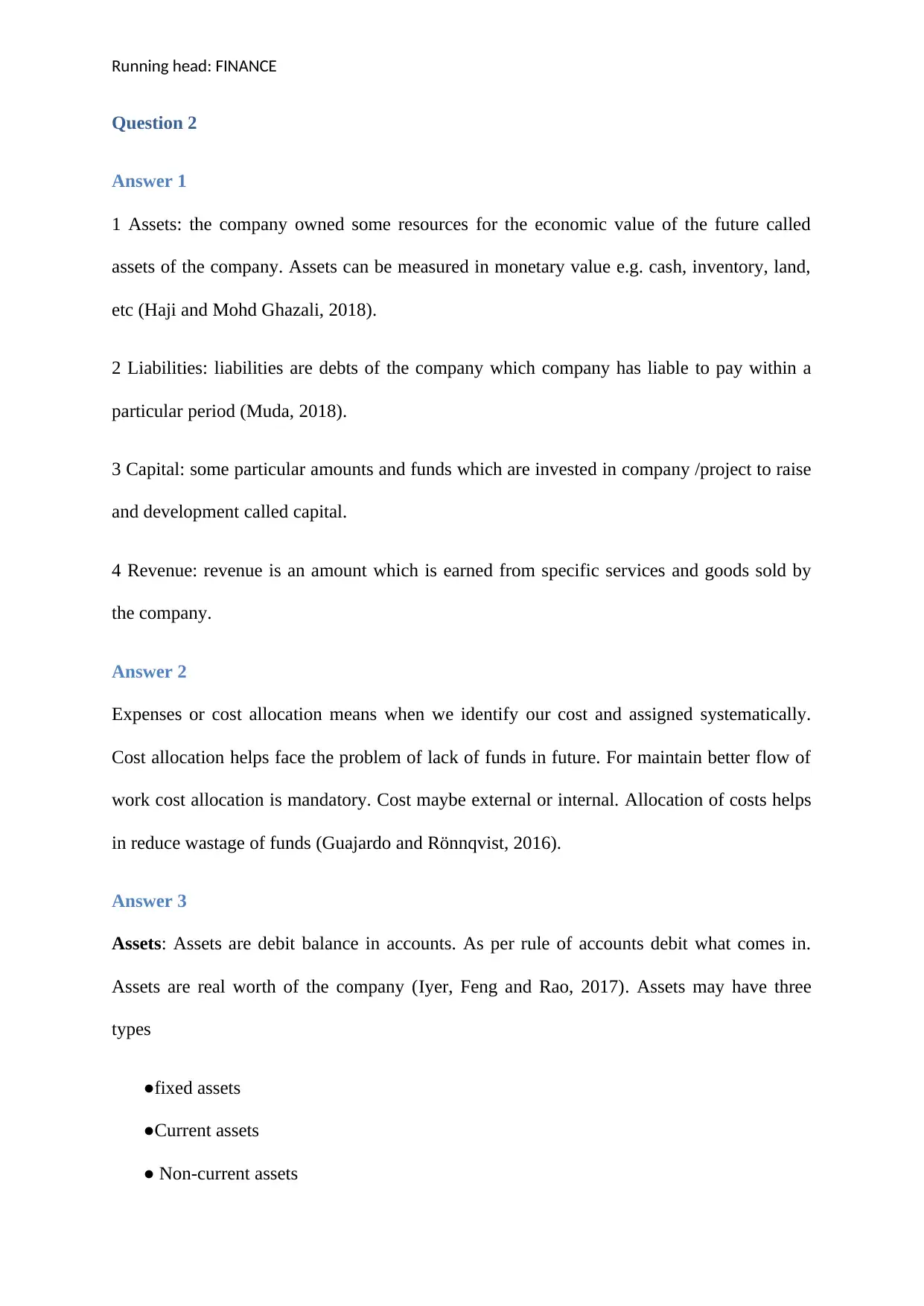
Running head: FINANCE
Question 2
Answer 1
1 Assets: the company owned some resources for the economic value of the future called
assets of the company. Assets can be measured in monetary value e.g. cash, inventory, land,
etc (Haji and Mohd Ghazali, 2018).
2 Liabilities: liabilities are debts of the company which company has liable to pay within a
particular period (Muda, 2018).
3 Capital: some particular amounts and funds which are invested in company /project to raise
and development called capital.
4 Revenue: revenue is an amount which is earned from specific services and goods sold by
the company.
Answer 2
Expenses or cost allocation means when we identify our cost and assigned systematically.
Cost allocation helps face the problem of lack of funds in future. For maintain better flow of
work cost allocation is mandatory. Cost maybe external or internal. Allocation of costs helps
in reduce wastage of funds (Guajardo and Rönnqvist, 2016).
Answer 3
Assets: Assets are debit balance in accounts. As per rule of accounts debit what comes in.
Assets are real worth of the company (Iyer, Feng and Rao, 2017). Assets may have three
types
●fixed assets
●Current assets
● Non-current assets
Question 2
Answer 1
1 Assets: the company owned some resources for the economic value of the future called
assets of the company. Assets can be measured in monetary value e.g. cash, inventory, land,
etc (Haji and Mohd Ghazali, 2018).
2 Liabilities: liabilities are debts of the company which company has liable to pay within a
particular period (Muda, 2018).
3 Capital: some particular amounts and funds which are invested in company /project to raise
and development called capital.
4 Revenue: revenue is an amount which is earned from specific services and goods sold by
the company.
Answer 2
Expenses or cost allocation means when we identify our cost and assigned systematically.
Cost allocation helps face the problem of lack of funds in future. For maintain better flow of
work cost allocation is mandatory. Cost maybe external or internal. Allocation of costs helps
in reduce wastage of funds (Guajardo and Rönnqvist, 2016).
Answer 3
Assets: Assets are debit balance in accounts. As per rule of accounts debit what comes in.
Assets are real worth of the company (Iyer, Feng and Rao, 2017). Assets may have three
types
●fixed assets
●Current assets
● Non-current assets
Secure Best Marks with AI Grader
Need help grading? Try our AI Grader for instant feedback on your assignments.
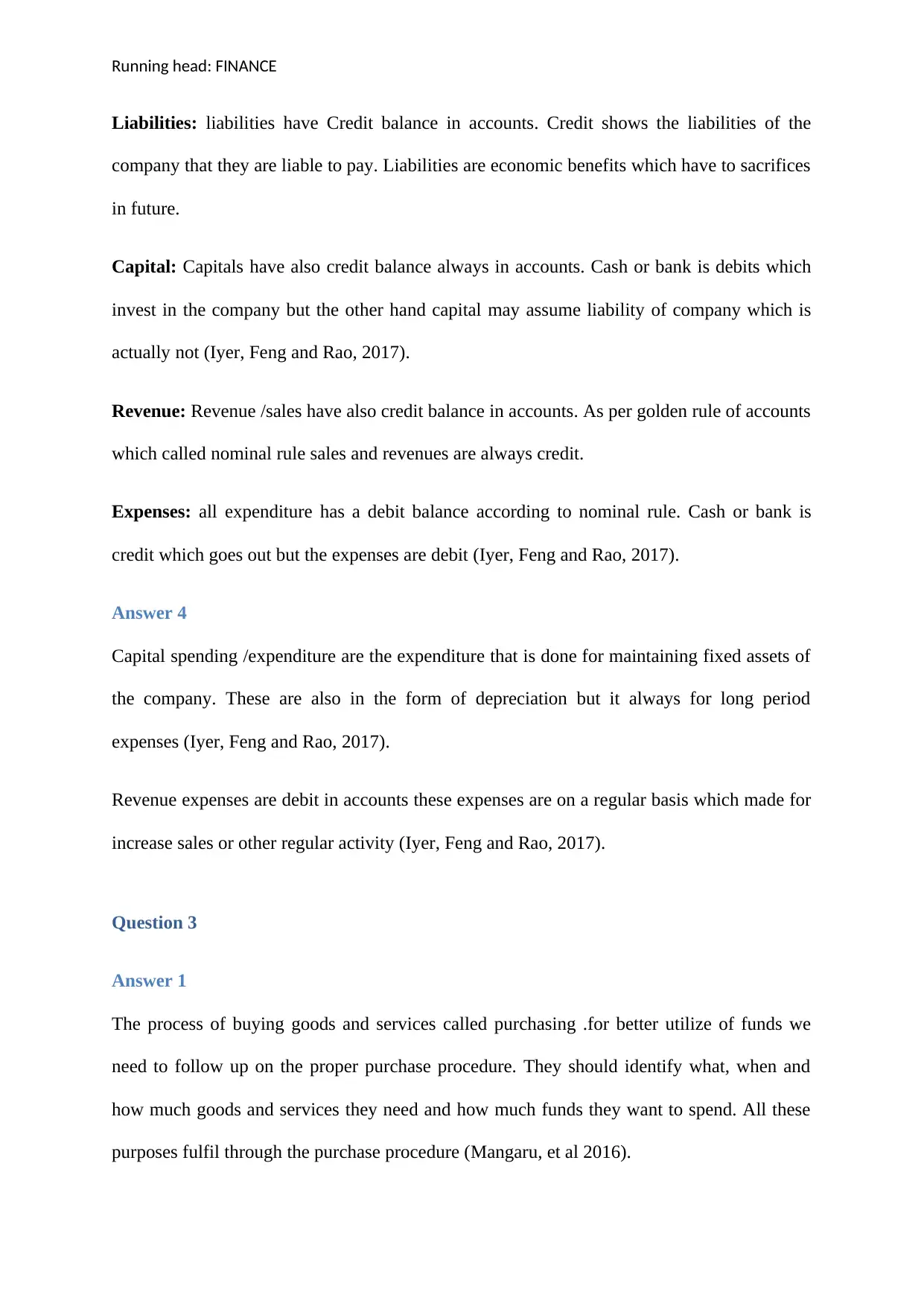
Running head: FINANCE
Liabilities: liabilities have Credit balance in accounts. Credit shows the liabilities of the
company that they are liable to pay. Liabilities are economic benefits which have to sacrifices
in future.
Capital: Capitals have also credit balance always in accounts. Cash or bank is debits which
invest in the company but the other hand capital may assume liability of company which is
actually not (Iyer, Feng and Rao, 2017).
Revenue: Revenue /sales have also credit balance in accounts. As per golden rule of accounts
which called nominal rule sales and revenues are always credit.
Expenses: all expenditure has a debit balance according to nominal rule. Cash or bank is
credit which goes out but the expenses are debit (Iyer, Feng and Rao, 2017).
Answer 4
Capital spending /expenditure are the expenditure that is done for maintaining fixed assets of
the company. These are also in the form of depreciation but it always for long period
expenses (Iyer, Feng and Rao, 2017).
Revenue expenses are debit in accounts these expenses are on a regular basis which made for
increase sales or other regular activity (Iyer, Feng and Rao, 2017).
Question 3
Answer 1
The process of buying goods and services called purchasing .for better utilize of funds we
need to follow up on the proper purchase procedure. They should identify what, when and
how much goods and services they need and how much funds they want to spend. All these
purposes fulfil through the purchase procedure (Mangaru, et al 2016).
Liabilities: liabilities have Credit balance in accounts. Credit shows the liabilities of the
company that they are liable to pay. Liabilities are economic benefits which have to sacrifices
in future.
Capital: Capitals have also credit balance always in accounts. Cash or bank is debits which
invest in the company but the other hand capital may assume liability of company which is
actually not (Iyer, Feng and Rao, 2017).
Revenue: Revenue /sales have also credit balance in accounts. As per golden rule of accounts
which called nominal rule sales and revenues are always credit.
Expenses: all expenditure has a debit balance according to nominal rule. Cash or bank is
credit which goes out but the expenses are debit (Iyer, Feng and Rao, 2017).
Answer 4
Capital spending /expenditure are the expenditure that is done for maintaining fixed assets of
the company. These are also in the form of depreciation but it always for long period
expenses (Iyer, Feng and Rao, 2017).
Revenue expenses are debit in accounts these expenses are on a regular basis which made for
increase sales or other regular activity (Iyer, Feng and Rao, 2017).
Question 3
Answer 1
The process of buying goods and services called purchasing .for better utilize of funds we
need to follow up on the proper purchase procedure. They should identify what, when and
how much goods and services they need and how much funds they want to spend. All these
purposes fulfil through the purchase procedure (Mangaru, et al 2016).
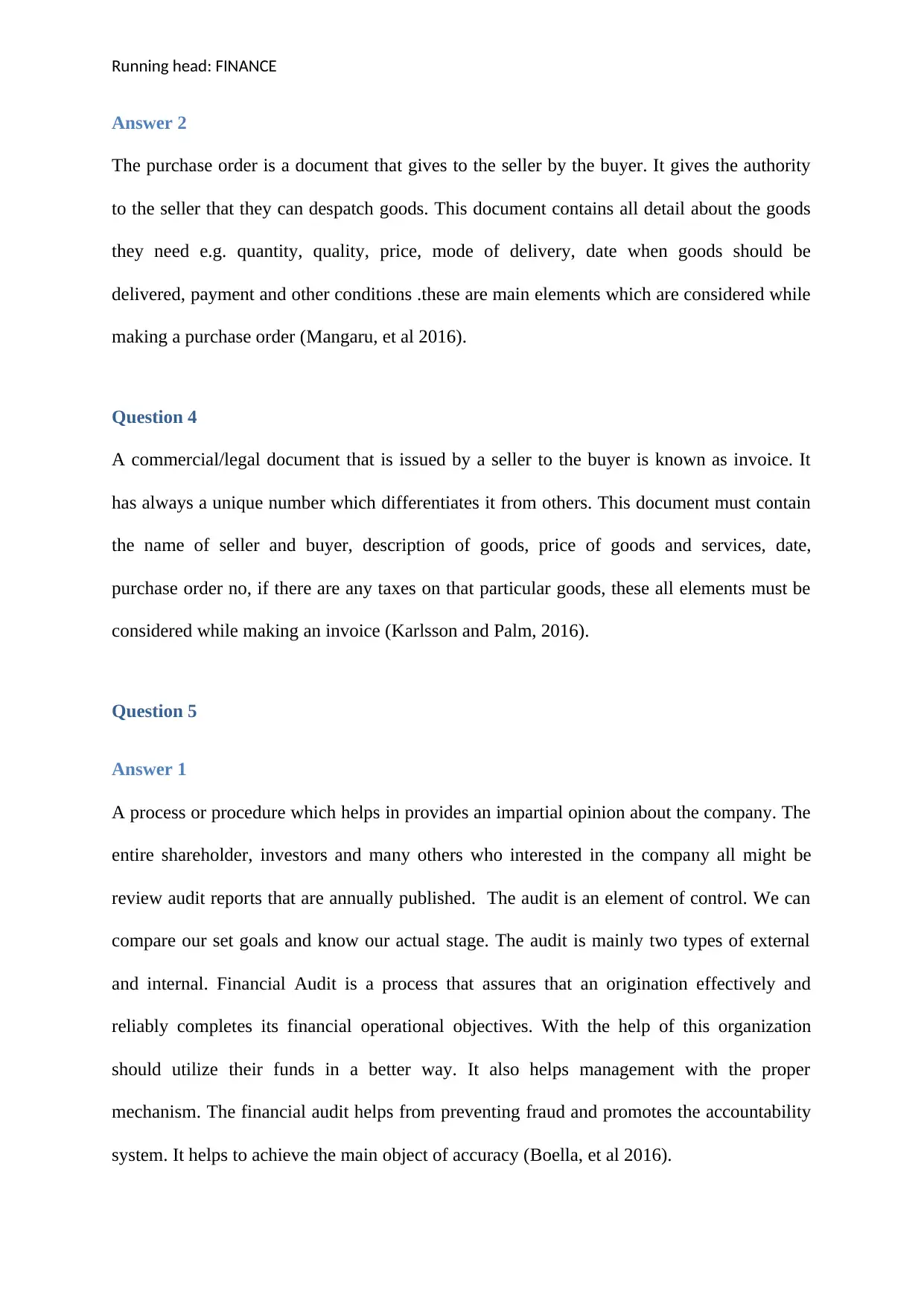
Running head: FINANCE
Answer 2
The purchase order is a document that gives to the seller by the buyer. It gives the authority
to the seller that they can despatch goods. This document contains all detail about the goods
they need e.g. quantity, quality, price, mode of delivery, date when goods should be
delivered, payment and other conditions .these are main elements which are considered while
making a purchase order (Mangaru, et al 2016).
Question 4
A commercial/legal document that is issued by a seller to the buyer is known as invoice. It
has always a unique number which differentiates it from others. This document must contain
the name of seller and buyer, description of goods, price of goods and services, date,
purchase order no, if there are any taxes on that particular goods, these all elements must be
considered while making an invoice (Karlsson and Palm, 2016).
Question 5
Answer 1
A process or procedure which helps in provides an impartial opinion about the company. The
entire shareholder, investors and many others who interested in the company all might be
review audit reports that are annually published. The audit is an element of control. We can
compare our set goals and know our actual stage. The audit is mainly two types of external
and internal. Financial Audit is a process that assures that an origination effectively and
reliably completes its financial operational objectives. With the help of this organization
should utilize their funds in a better way. It also helps management with the proper
mechanism. The financial audit helps from preventing fraud and promotes the accountability
system. It helps to achieve the main object of accuracy (Boella, et al 2016).
Answer 2
The purchase order is a document that gives to the seller by the buyer. It gives the authority
to the seller that they can despatch goods. This document contains all detail about the goods
they need e.g. quantity, quality, price, mode of delivery, date when goods should be
delivered, payment and other conditions .these are main elements which are considered while
making a purchase order (Mangaru, et al 2016).
Question 4
A commercial/legal document that is issued by a seller to the buyer is known as invoice. It
has always a unique number which differentiates it from others. This document must contain
the name of seller and buyer, description of goods, price of goods and services, date,
purchase order no, if there are any taxes on that particular goods, these all elements must be
considered while making an invoice (Karlsson and Palm, 2016).
Question 5
Answer 1
A process or procedure which helps in provides an impartial opinion about the company. The
entire shareholder, investors and many others who interested in the company all might be
review audit reports that are annually published. The audit is an element of control. We can
compare our set goals and know our actual stage. The audit is mainly two types of external
and internal. Financial Audit is a process that assures that an origination effectively and
reliably completes its financial operational objectives. With the help of this organization
should utilize their funds in a better way. It also helps management with the proper
mechanism. The financial audit helps from preventing fraud and promotes the accountability
system. It helps to achieve the main object of accuracy (Boella, et al 2016).
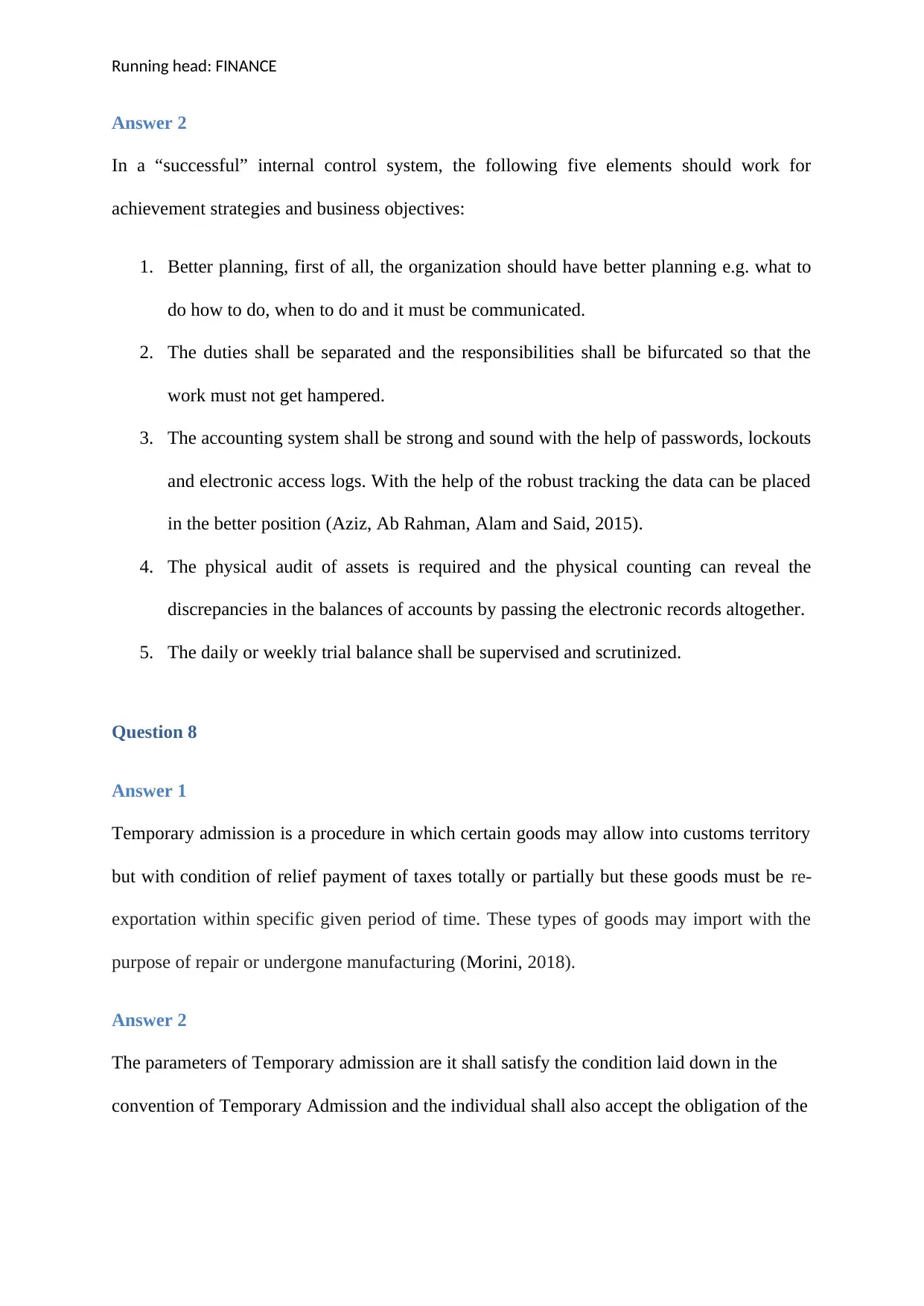
Running head: FINANCE
Answer 2
In a “successful” internal control system, the following five elements should work for
achievement strategies and business objectives:
1. Better planning, first of all, the organization should have better planning e.g. what to
do how to do, when to do and it must be communicated.
2. The duties shall be separated and the responsibilities shall be bifurcated so that the
work must not get hampered.
3. The accounting system shall be strong and sound with the help of passwords, lockouts
and electronic access logs. With the help of the robust tracking the data can be placed
in the better position (Aziz, Ab Rahman, Alam and Said, 2015).
4. The physical audit of assets is required and the physical counting can reveal the
discrepancies in the balances of accounts by passing the electronic records altogether.
5. The daily or weekly trial balance shall be supervised and scrutinized.
Question 8
Answer 1
Temporary admission is a procedure in which certain goods may allow into customs territory
but with condition of relief payment of taxes totally or partially but these goods must be re-
exportation within specific given period of time. These types of goods may import with the
purpose of repair or undergone manufacturing (Morini, 2018).
Answer 2
The parameters of Temporary admission are it shall satisfy the condition laid down in the
convention of Temporary Admission and the individual shall also accept the obligation of the
Answer 2
In a “successful” internal control system, the following five elements should work for
achievement strategies and business objectives:
1. Better planning, first of all, the organization should have better planning e.g. what to
do how to do, when to do and it must be communicated.
2. The duties shall be separated and the responsibilities shall be bifurcated so that the
work must not get hampered.
3. The accounting system shall be strong and sound with the help of passwords, lockouts
and electronic access logs. With the help of the robust tracking the data can be placed
in the better position (Aziz, Ab Rahman, Alam and Said, 2015).
4. The physical audit of assets is required and the physical counting can reveal the
discrepancies in the balances of accounts by passing the electronic records altogether.
5. The daily or weekly trial balance shall be supervised and scrutinized.
Question 8
Answer 1
Temporary admission is a procedure in which certain goods may allow into customs territory
but with condition of relief payment of taxes totally or partially but these goods must be re-
exportation within specific given period of time. These types of goods may import with the
purpose of repair or undergone manufacturing (Morini, 2018).
Answer 2
The parameters of Temporary admission are it shall satisfy the condition laid down in the
convention of Temporary Admission and the individual shall also accept the obligation of the
Paraphrase This Document
Need a fresh take? Get an instant paraphrase of this document with our AI Paraphraser
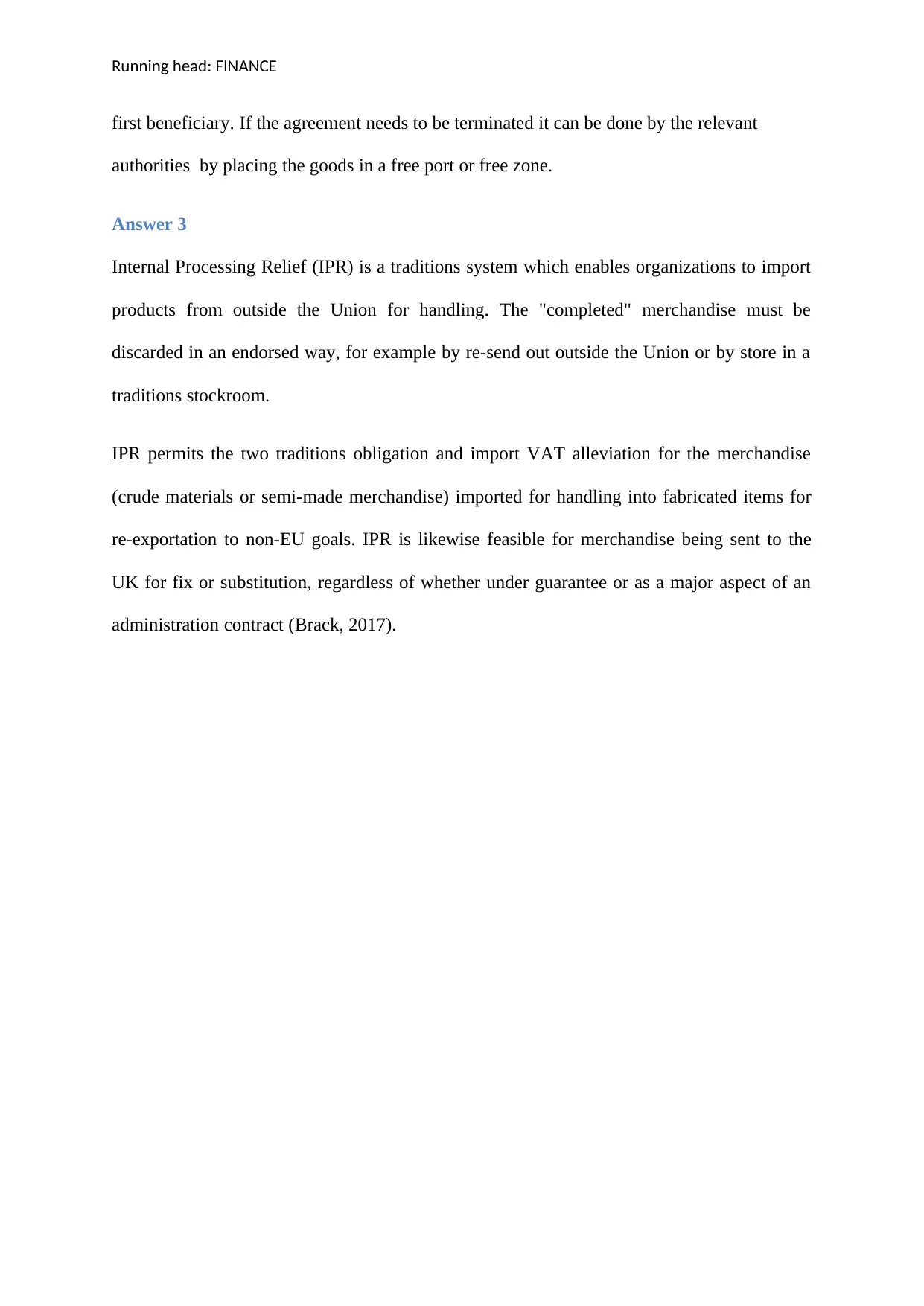
Running head: FINANCE
first beneficiary. If the agreement needs to be terminated it can be done by the relevant
authorities by placing the goods in a free port or free zone.
Answer 3
Internal Processing Relief (IPR) is a traditions system which enables organizations to import
products from outside the Union for handling. The "completed" merchandise must be
discarded in an endorsed way, for example by re-send out outside the Union or by store in a
traditions stockroom.
IPR permits the two traditions obligation and import VAT alleviation for the merchandise
(crude materials or semi-made merchandise) imported for handling into fabricated items for
re-exportation to non-EU goals. IPR is likewise feasible for merchandise being sent to the
UK for fix or substitution, regardless of whether under guarantee or as a major aspect of an
administration contract (Brack, 2017).
first beneficiary. If the agreement needs to be terminated it can be done by the relevant
authorities by placing the goods in a free port or free zone.
Answer 3
Internal Processing Relief (IPR) is a traditions system which enables organizations to import
products from outside the Union for handling. The "completed" merchandise must be
discarded in an endorsed way, for example by re-send out outside the Union or by store in a
traditions stockroom.
IPR permits the two traditions obligation and import VAT alleviation for the merchandise
(crude materials or semi-made merchandise) imported for handling into fabricated items for
re-exportation to non-EU goals. IPR is likewise feasible for merchandise being sent to the
UK for fix or substitution, regardless of whether under guarantee or as a major aspect of an
administration contract (Brack, 2017).
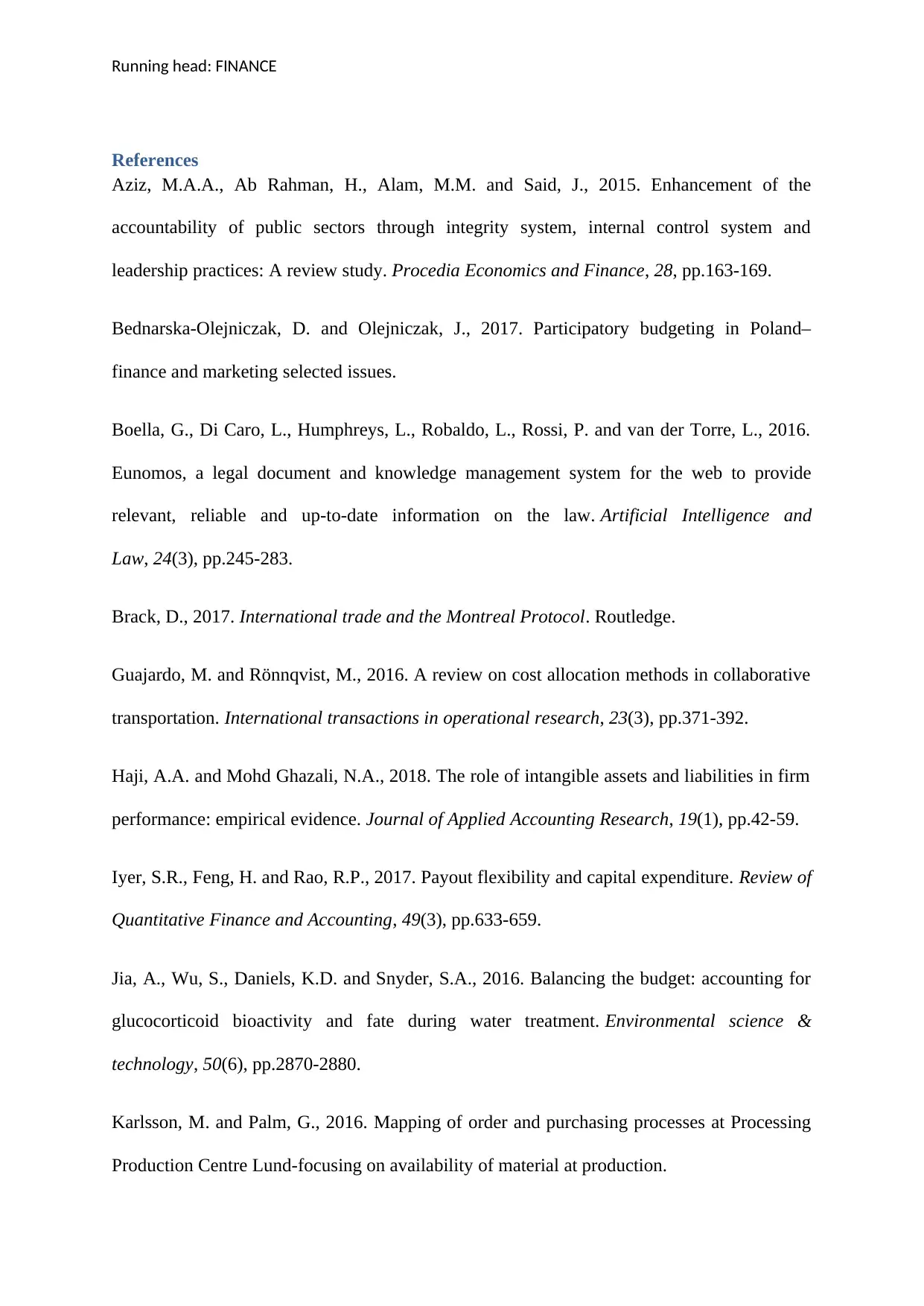
Running head: FINANCE
References
Aziz, M.A.A., Ab Rahman, H., Alam, M.M. and Said, J., 2015. Enhancement of the
accountability of public sectors through integrity system, internal control system and
leadership practices: A review study. Procedia Economics and Finance, 28, pp.163-169.
Bednarska-Olejniczak, D. and Olejniczak, J., 2017. Participatory budgeting in Poland–
finance and marketing selected issues.
Boella, G., Di Caro, L., Humphreys, L., Robaldo, L., Rossi, P. and van der Torre, L., 2016.
Eunomos, a legal document and knowledge management system for the web to provide
relevant, reliable and up-to-date information on the law. Artificial Intelligence and
Law, 24(3), pp.245-283.
Brack, D., 2017. International trade and the Montreal Protocol. Routledge.
Guajardo, M. and Rönnqvist, M., 2016. A review on cost allocation methods in collaborative
transportation. International transactions in operational research, 23(3), pp.371-392.
Haji, A.A. and Mohd Ghazali, N.A., 2018. The role of intangible assets and liabilities in firm
performance: empirical evidence. Journal of Applied Accounting Research, 19(1), pp.42-59.
Iyer, S.R., Feng, H. and Rao, R.P., 2017. Payout flexibility and capital expenditure. Review of
Quantitative Finance and Accounting, 49(3), pp.633-659.
Jia, A., Wu, S., Daniels, K.D. and Snyder, S.A., 2016. Balancing the budget: accounting for
glucocorticoid bioactivity and fate during water treatment. Environmental science &
technology, 50(6), pp.2870-2880.
Karlsson, M. and Palm, G., 2016. Mapping of order and purchasing processes at Processing
Production Centre Lund-focusing on availability of material at production.
References
Aziz, M.A.A., Ab Rahman, H., Alam, M.M. and Said, J., 2015. Enhancement of the
accountability of public sectors through integrity system, internal control system and
leadership practices: A review study. Procedia Economics and Finance, 28, pp.163-169.
Bednarska-Olejniczak, D. and Olejniczak, J., 2017. Participatory budgeting in Poland–
finance and marketing selected issues.
Boella, G., Di Caro, L., Humphreys, L., Robaldo, L., Rossi, P. and van der Torre, L., 2016.
Eunomos, a legal document and knowledge management system for the web to provide
relevant, reliable and up-to-date information on the law. Artificial Intelligence and
Law, 24(3), pp.245-283.
Brack, D., 2017. International trade and the Montreal Protocol. Routledge.
Guajardo, M. and Rönnqvist, M., 2016. A review on cost allocation methods in collaborative
transportation. International transactions in operational research, 23(3), pp.371-392.
Haji, A.A. and Mohd Ghazali, N.A., 2018. The role of intangible assets and liabilities in firm
performance: empirical evidence. Journal of Applied Accounting Research, 19(1), pp.42-59.
Iyer, S.R., Feng, H. and Rao, R.P., 2017. Payout flexibility and capital expenditure. Review of
Quantitative Finance and Accounting, 49(3), pp.633-659.
Jia, A., Wu, S., Daniels, K.D. and Snyder, S.A., 2016. Balancing the budget: accounting for
glucocorticoid bioactivity and fate during water treatment. Environmental science &
technology, 50(6), pp.2870-2880.
Karlsson, M. and Palm, G., 2016. Mapping of order and purchasing processes at Processing
Production Centre Lund-focusing on availability of material at production.
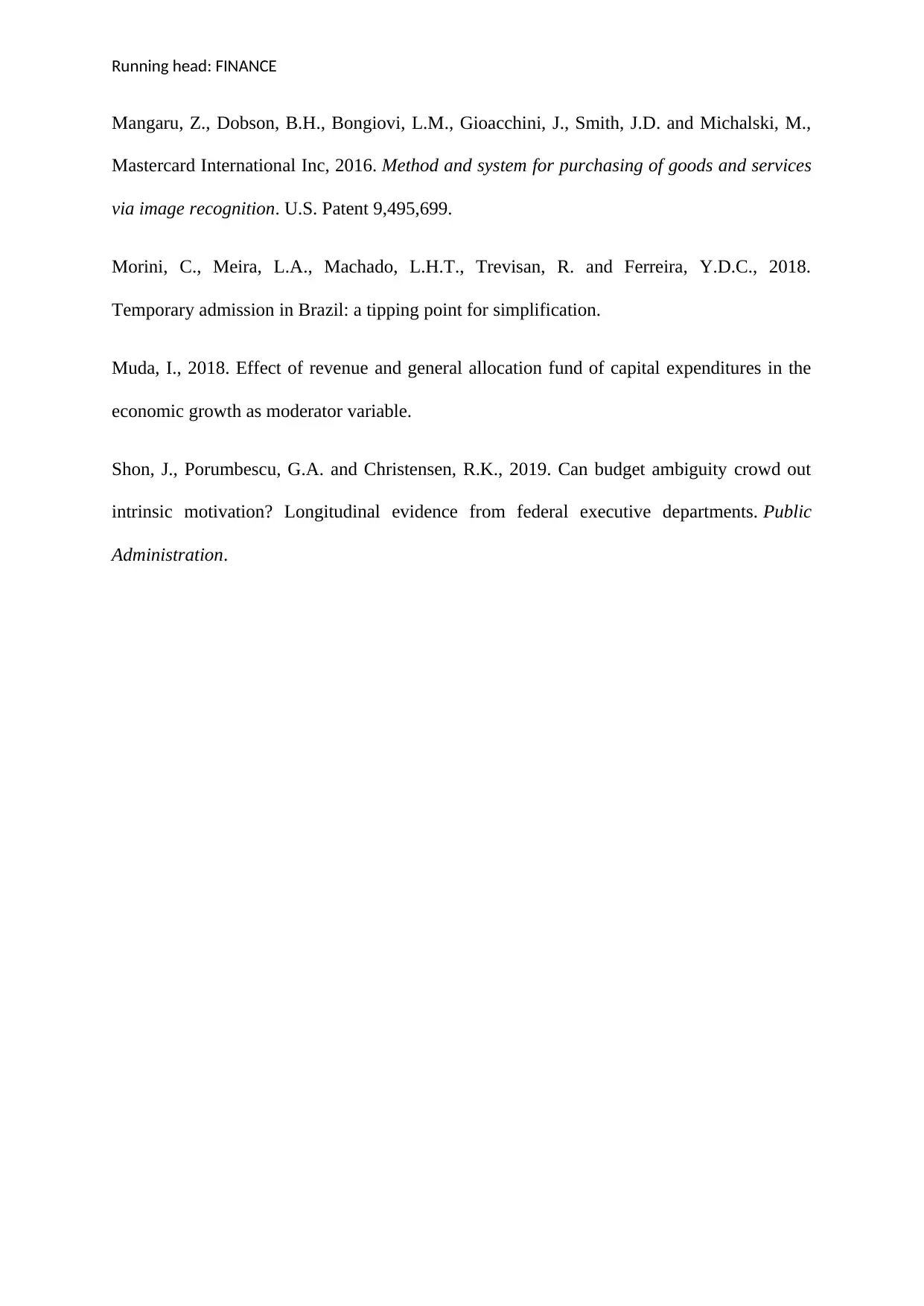
Running head: FINANCE
Mangaru, Z., Dobson, B.H., Bongiovi, L.M., Gioacchini, J., Smith, J.D. and Michalski, M.,
Mastercard International Inc, 2016. Method and system for purchasing of goods and services
via image recognition. U.S. Patent 9,495,699.
Morini, C., Meira, L.A., Machado, L.H.T., Trevisan, R. and Ferreira, Y.D.C., 2018.
Temporary admission in Brazil: a tipping point for simplification.
Muda, I., 2018. Effect of revenue and general allocation fund of capital expenditures in the
economic growth as moderator variable.
Shon, J., Porumbescu, G.A. and Christensen, R.K., 2019. Can budget ambiguity crowd out
intrinsic motivation? Longitudinal evidence from federal executive departments. Public
Administration.
Mangaru, Z., Dobson, B.H., Bongiovi, L.M., Gioacchini, J., Smith, J.D. and Michalski, M.,
Mastercard International Inc, 2016. Method and system for purchasing of goods and services
via image recognition. U.S. Patent 9,495,699.
Morini, C., Meira, L.A., Machado, L.H.T., Trevisan, R. and Ferreira, Y.D.C., 2018.
Temporary admission in Brazil: a tipping point for simplification.
Muda, I., 2018. Effect of revenue and general allocation fund of capital expenditures in the
economic growth as moderator variable.
Shon, J., Porumbescu, G.A. and Christensen, R.K., 2019. Can budget ambiguity crowd out
intrinsic motivation? Longitudinal evidence from federal executive departments. Public
Administration.
1 out of 10
Related Documents
Your All-in-One AI-Powered Toolkit for Academic Success.
+13062052269
info@desklib.com
Available 24*7 on WhatsApp / Email
![[object Object]](/_next/static/media/star-bottom.7253800d.svg)
Unlock your academic potential
© 2024 | Zucol Services PVT LTD | All rights reserved.





